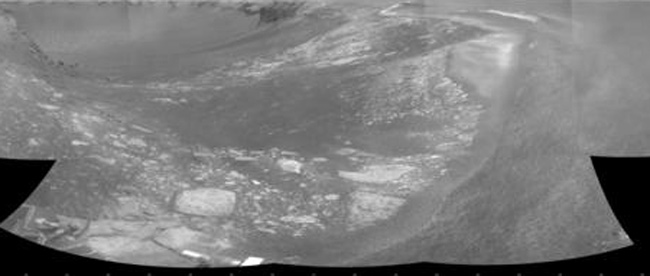After Dust Storms, Mars Rover Set to Enter Giant Crater

Aftersurviving near fatal dust storms on Mars, NASA's Opportunity rover is gearingup for its long-awaited trek inside an expansive crater on the red planet'ssurface.
Opportunity could begin descending down into Mars'giant Victoria Crater by Sept. 11 after spending two months hunkered down to waitout sunlight-blotting storms that nearly starvedthe solar-powered rover and its robotic twin, Spirit. The rover spent thisweek rolling ever closer to entry point into Victoria Crater.
"Opportunitymight be ready for that first 'toe dip' into the crater as early as nextweek," said John Callas, project manager for the Mars rover mission at the JetPropulsion Laboratory in Pasadena,Calif., in a Fridaystatement.
Victoria isthe largest crater visited by Opportunity during a 43-month trek across its MeridianiPlanum landing site. A bright layer of exposed rock inside the 2,400-foot wide(730-meter wide) crater may yield tantalizing clues of interactions betweenMars' surface and atmosphere millions of years ago, mission researchers said.
To preparefor the descent into Victoria Crater, Opportunity's handlers will send the rovertoan entry point that will allow clear access to the bright band of rockabout 40 feet (12 meters) blow the depression's rim. The rover will then backout a bit to check how much it may slip during the descent.
"Wechose a point that gives us a straight path down, instead of drivingcross-slope from our current location," said JPL rover driver PaoloBellutta. "The rock surface on which Opportunity will be driving will provide good traction and control of its path intothe crater."
Spirit,meanwhile, climbed atop a rock plateau dubbed "Home Plate' on Wednesday.The plateau had been a long-time destination for Spirit as the rover exploresits Gusev Crater landing site.
Get the Space.com Newsletter
Breaking space news, the latest updates on rocket launches, skywatching events and more!
Healthchecks planned
But beforeOpportunity can begin its crater descent, scientists on Earth will check thehealth of two vital instruments to ensure the months-long martian dust stormshaven't crippled their ability to collect data.
If the duststorms have not impacted a microscope-like camera on Opportunity's robotic arm,mission managers will use it to inspect a crucial mast-mounted mirror.
The mirrorreflects infrared light into the rover's Miniature Thermal EmissionSpectrometer (Mini-TES), allowing scientists to determine the minerals presenton the martian surface. Some data from the spectrometer's last use hinted thatthe mirror, which can also swivel to cover a mast opening as a dust guard, maynot be moving properly.
"Itwould be the first permanent loss of an instrument on either rover," saidrover science principal investigator Steven Squyres, of Cornell University inIthaca, N.Y. "But we'll see."
The dust woes of Opportunity and Spirit began in late June, when astronomers spottedgrowing dust storms on the red planet's surface. The storms swelled to blotout much of the sunlight on the planet's surface, leading some mission managersto worry that the solar-powered rovers could starve from lack adequate energysupplies.
By lateAugust, the storms had subsided enoughto allow Opportunity and Spirit to once more explore Mars. Opportunity, which weatheredthe storms while perched on the rim of Victoria, resumed preparations to enterthe crater.
All-weatherrovers
Originallyslated to spend three Earth months exploring Mars, Spirit and Opportunity arenow in their fourth year of red planet roving. The two robots have uncoveredevidence of the planet's ancient watery past, scaled hills and studied amartian meteorite among their manyscientific exploits.
While dustis still settling from Mars' recent storms, wind gusts have been aidingOpportunity?s recovery by blowing away dust particles from its solar arraysalmost as fast as they are deposited, mission managers said.
"Theserovers are tough," said Alan Stern, NASA's associate administrator forscience missions, in a Friday statement. "They faced dusty winds, powerstarvation and other challenges--and survived."
- Top 10 Mars Rovers' Most Amazing Discoveries
- VIDEO: Mars Rover Team Ponders Mission's End
- Complete Coverage of the Mars Rovers
Join our Space Forums to keep talking space on the latest missions, night sky and more! And if you have a news tip, correction or comment, let us know at: community@space.com.

Tariq is the Editor-in-Chief of Space.com and joined the team in 2001, first as an intern and staff writer, and later as an editor. He covers human spaceflight, exploration and space science, as well as skywatching and entertainment. He became Space.com's Managing Editor in 2009 and Editor-in-Chief in 2019. Before joining Space.com, Tariq was a staff reporter for The Los Angeles Times covering education and city beats in La Habra, Fullerton and Huntington Beach. In October 2022, Tariq received the Harry Kolcum Award for excellence in space reporting from the National Space Club Florida Committee. He is also an Eagle Scout (yes, he has the Space Exploration merit badge) and went to Space Camp four times as a kid and a fifth time as an adult. He has journalism degrees from the University of Southern California and New York University. You can find Tariq at Space.com and as the co-host to the This Week In Space podcast with space historian Rod Pyle on the TWiT network. To see his latest project, you can follow Tariq on Twitter @tariqjmalik.









